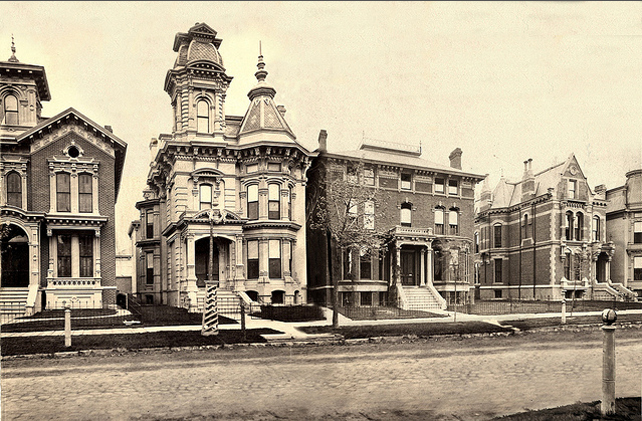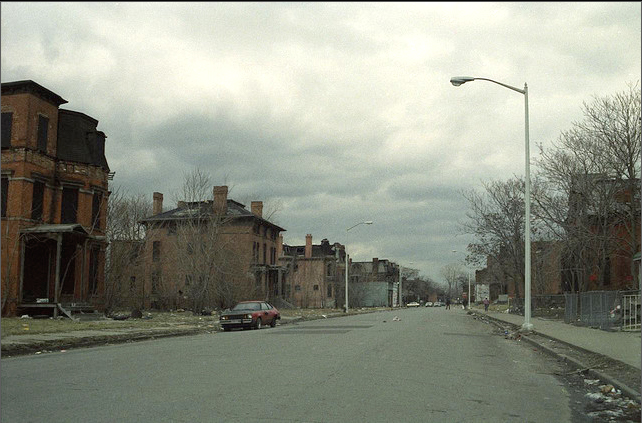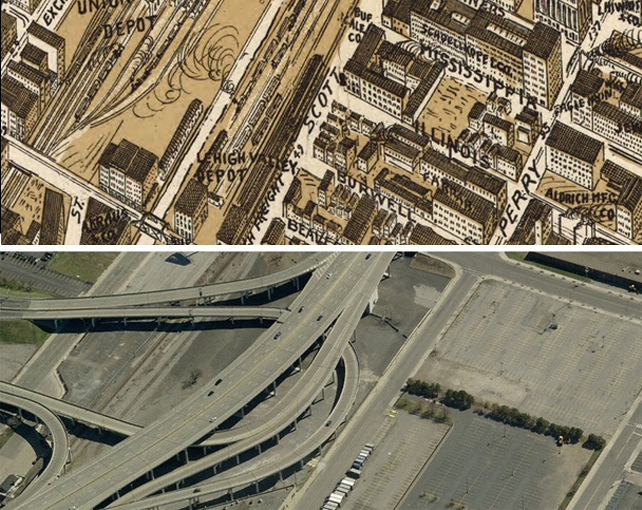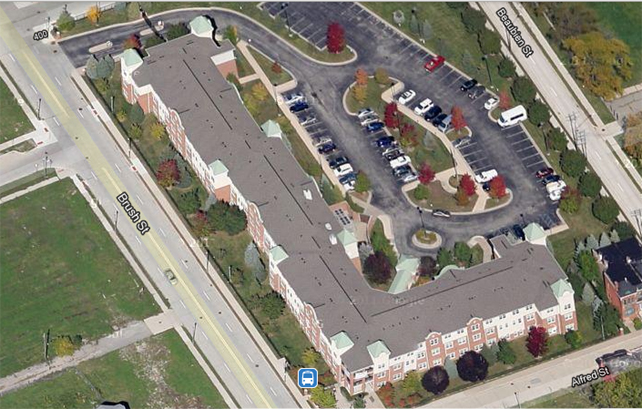After five years of ‘The Great Financial Crisis’ there is a sense of relief as Christmas approaches. There is nervous talk by central bankers and economists, but also hope of ‘recovery’ and a following new period of prosperity … tomorrow.
It’s always tomorrow: where this recovery is going to come from or what will drive it nobody really knows, It is just taken on faith that a recovery is certain to arrive because recoveries have always arrived in the past. “Why not?” the economists ask, “It’s never different this time!”
The sense of security is misleading and unsettling. We are like a person wearing a sweater with a thread caught on something, we are walking away … Pulling the string does not blow up the sweater or cause it to crash. The sweater diminishes without our being too much aware of it. There is little drama, only a Great Unraveling. Instead of a strong economy, we have a string economy, the pulling of which is invisible to economists.
(Unknown photographer) Fairy-tale palaces for the well-to-do in the Paris of the Midwest, on Alfred Street in Brush Park in Detroit in 1881. It was all a fantastic dream, a stage-set for Victorian manners and unimaginable prosperity without end, a gilded age, the product of the settlement of the far West, of the overreaching railroads and steamships … and of millions of highly skilled immigrants from Europe.
Brush Park was a psychedelic dream-scape of hundreds of extravagant, gilded mansions, with hundreds more throughout the city: not so much an idea but an escape from the necessity of having to think about anything at all. It was as if the prosperity wasn’t real but needed physical manifestations, each more outlandish than the next … to reassure those with the most that most was indeed what they had.
What the most have today is an irksome and uncertain non-crisis, a fake. Relief resides entirely in the form of central bank credit. These banks offer trillions in low-cost loans to both governments and the finance industry so that these establishments might dodge the consequences of the gigantic debts they have already taken on. There is no gilded palace on Alfred Street for this debt for it must squirreled away out of sight. Managers hope that ordinary citizens will ignore the creaking colossus until it is safe to set it loose again, debt giving rise to still more debt against a renewed backdrop of ‘growth’.
The only gain from the central bank lending/hiding strategy is a reduction of the interest cost and an escape from accountability. Both the reduction and the escape are temporary. The banking sector receives the benefits of interest reduction while the costs are shifted to the citizens. Escape keeps finance scoundrels out of jail until the statute of limitation expires. Nothing is done to reduce the overall debt burden, indeed nothing can be done! Modernity and industry both require a constant increase of debt and cannot tolerate any decrease. ‘Growth’ is a measure of the increase in debt and therefor a measure of wealth! Without the general increase of debt it is impossible for tycoons to gain more beyond what they already have. In a debt-constrained world, one tycoon can only gain when other tycoons lose. It is a pitiless world indeed that sets one tycoon against the others.
Any increase in debt must take place in the private sector because wealth cannot exist unless it can be extracted at great pain from the citizens. This is because money, wealth and debt are all interchangeable claims against the non-tycoons’ vanishingly small allotments of time. A tycoon can always obtain more money but no human can gain more time: for wealth to have meaning it must be worth what is dear to everyone, not just tycoons! To be a tycoon is to have a great surplus of others’ time.
Debt repayments must therefor be extracted from the public, the higher the cost to the public the more useful/satisfying wealth is for the tycoon … being a sadistic libertine is a characteristic which enables an individual to become a tycoon in the first place.
Sadly, the private sector is unable to increase its supply of debt as there is already too much debt for ordinary economic activity to manage properly. Enter the central banks, which lend in the place of the private sector. Inflationists cry that this is horrible, like beating a dog with a curtain rod … Having the central banks or the government write checks to tycoons simply will not do, it’s bad manners, the payments do not represent wealth, in fact do not represent anything. The certainly do not represent anyone’s time.
This concern is misplaced for two reasons. One is because lending to tycoons is what central banks do: lending-plus-sadism is how tycoons get to be that way. Second, the absence of real money is considered to be temporary. With the loans offered by the central banks, there is certain to be more private sector credit made available … tomorrow.
There is no inflation because the central banks do not add to the private sector debt provision, they replace it. Whatever amounts of credit the central bank offers is less than what is retired or destroyed by private sector deleveraging. Even as the central banks’ expand their balance sheets, the private sectors’ balance sheets contract more. Without the efforts of the central banks there is no credit to be had with dire consequences all around!
The governments could issue currency without borrowing and use it to retire some of the debt. This would not add to the supply of money because retiring the debt would extinguish newly-issued currency at the same time. The governments so far have refused to do this. Bankers would object … as would the tycoons who desire to extract wealth from the workers’ bloodstreams, not from the government. The government could issue sufficient currency so that the supply of money expands enough for the tycoons to gain more of it. Having the government write checks to tycoons simply will not do, it’s bad manners, etcetera …
Meanwhile, the Establishment attempts to prop up key men everywhere around the world by any means necessary. Any institution that is deemed to be ‘systemically important’ is supported with the ordinary citizens’ credit … except for those things the same Establishment deems worthy of being blown up by drones or commandos. Non-key institutions such as Detroit and other American cities are abandoned to molder then collapse.
The citizens mutter, they are under a cloud that grows longer and darker with each pull of the string. Unemployment relentlessly increases, there are rumors of ‘austerity’ to be added onto the thermodynamic variety that emerges from diminished energy availability. The establishment has only one tactic: to add more debt, which has typically increased since the beginning of the industrial revolution. Debt has become non-productive, we have the unraveling sweater economy as a consequence … there needs to be another approach.
We are caught between what we want and what we need. We want it all, we feel entitled: we are like children. We cannot help ourselves. The yarn is pulled and the sweater becomes very small, the bottom is now at our armpits. We know there are steps that we must take … we must stop pulling the string … but we refuse to take them.
Alfred street in 1993 (Unknown photographer for City of Detroit). The house behind the car is the third house from the left in the top photo. Modern Detroit, a first-world slum:
Slums are a product of modernity just the same as automobiles and jet airplanes. They are economically segregated areas, places where society’s losers are swept. Modernity washes its hands of the slum-dwellers then moves onto other business … the creation of more slum dwellers. Slums are the end product of social Darwinism, the necessary ‘yin’ to business success ‘yang’.
More success = more slums. Failure of the process also = more slums. Modernity asserts that it eliminates poverty. Slums stand as evidence that modernity creates poverty. More modernity = more poverty.
As with Mumbai and Nairobi, so goes Detroit and other slum-cities, the product of- as well as destination for industrial prosperity.
Detroit was undone by the extraction of time from tens-of-millions of Americans by Detroit’s auto- and other business tycoons. At the end of the day, America had no time for Detroit. The stock market crash of 1929 and the following Depression ruined many of the old Detroit families. The manors were sold or divided into apartments or configured as rooming houses for auto workers. Others were demolished and replaced with cheaply built stores, shabby institutional buildings or parking lots. In 1935, the immense Brewster-Douglass public housing project for the ‘working poor’ was built at the far end of Alfred Street, just out of range of this photograph. War production saw the city filled with hundreds of thousands of job-seekers and factory workers who required housing. Many of these job-seekers were Negroes from the American south. Blacks were undesirables in nearly every Detroit neighborhood. As a consequence, housing was very expensive in neighborhoods where they were allowed to settle, much more so than for whites who could live anywhere in the city. Housing for blacks was also in far more advanced states of decay. Tension between races exploded in 1943 with a city-wide race riot that killed 34, with thousands arrested and soldiers patrolling the streets.
After the war, whites who could fled the city for the ballooning suburbs, a period of migration that lasted for decades. Cities are made and broken by flows of capital and human beings. Detroit originally grew and took form from the incoming tide of European immigrants who built in the manner and with the materials they were familiar. The craftsmen who built the fairy castles were replaced with unskilled agricultural workers looking to toil in the expanding automobile factories, these workers had no background or interest in city-building. They needed a paycheck, the city would take care of itself.
Instead, big business ‘took care’ of the city. Beginning in 1908 came the machines: the city was steadily made over as an auto habitat. It didn’t take much: Detroit’s street plan was laid out before the automobile — the width of the streets and boulevards and vast spaces anticipated it. The distances were too great for walking, often there was no ‘place’ to walk to. Starting in the 1950s and 60s, the city was divided by superhighways. the Chrysler and Edsel Ford freeways were built north and east of Brush Park, flattening the commercial districts and cutting off neighborhood from the rest of the city … by 1970, after another race riot, the Brush Park neighborhood was abandoned to street criminals and drug addicts. The fairy palaces grew furry and gray with rot, they collapsed or were demolished one at a time, the housing projects were also abandoned then stripped. Today there are a couple of dozen occupied houses in this neighborhood, the rest is weed-covered vacant space dotted with gaping ruins and some low-quality replacement housing and commercial buildings.
Not just Detroit: the machines overran neighborhoods and commercial districts in cities all over the country, this happens to be Buffalo, New York (Atlantic) James Howard Kunstler calls this the suicide of Midwest American cities, instead it is inadvertent suburbanization. The post-auto density and the form of building within the cities is identical to that of the surrounding suburbs. Replacement construction in places like Brush Park is identical to that of the suburb: quickly constructed low-rise apartment complexes or ‘pods’ of identical, cheaply designed and built vinyl-sided shacks.
Brush Park- Alfred Street by way of Google. It is only a matter of time before these ‘new’ buildings go the way of their predecessors. There is no reason for anyone to care about them, any more than they did for the housing projects or the fairy palaces.
Nothing in the Brush Park neighborhood or the rest of the city was made to withstand the test of time, the appeal of the place was narrowly immediate. There was no ‘greater place’ that the original neighborhood could be an indispensable part of. Detroit was a collection of unrelated buildings and occupation districts. The Park was created as a ghetto, a place of confinement for rich people who had no choice but to look at each others’ wealth every day and become bored with it. The vast endeavor could never be re-purposed into anything other than a self-referential institution, the same as an insane asylum or a water tower. There was nothing transcendent, every building was a single-function enterprise, created to mandate/channel behavior.
No doubt there are many who could rebuild the entirety of Brush Park as it was … as a museum piece. The Federal government could certainly do it for the cost of one mile of urban freeway. The fashion impulse that made the place possible 140 years ago no longer exists. Americans have nothing in the way of tools that would give such a project form other than nostalgia and wonder over building and design skills that were common in the late-nineteenth century but no longer exist. We don’t know how to create engaging urban spaces and we don’t know how to inhabit them. We have forgotten how to be Victorian merchants. We know how to get in our cars and drive.
Which is why we cling to the immediate present so desperately, we really don’t know how to do anything else. For us to learn is too dangerous because we don’t have the luxury of time, it has been stolen by the tycoons! By the time … we find out what danger we are in it will be to late to do anything about it.



